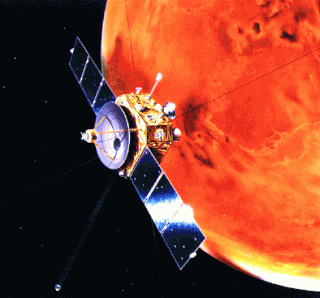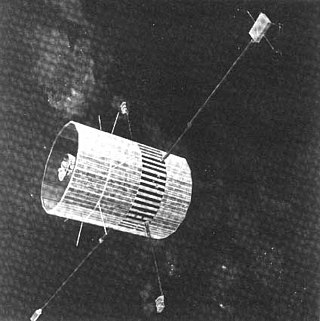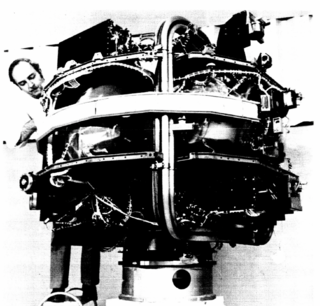Related Research Articles

Nozomi was a Japanese Mars orbiter that failed to reach Mars due to electrical failure. It was constructed by the Institute of Space and Astronautical Science, University of Tokyo and launched on July 4, 1998, at 03:12 JST with an on-orbit dry mass of 258 kg and 282 kg of propellant. The Nozomi mission was terminated on December 31, 2003.

Advanced Composition Explorer is a NASA Explorer program satellite and space exploration mission to study matter comprising energetic particles from the solar wind, the interplanetary medium, and other sources.

The Global Geospace Science (GGS) Wind satellite is a NASA science spacecraft designed to study radio waves and plasma that occur in the solar wind and in the Earth's magnetosphere. It was launched on 1 November 1994, at 09:31:00 UTC, from launch pad LC-17B at Cape Canaveral Air Force Station (CCAFS) in Merritt Island, Florida, aboard a McDonnell Douglas Delta II 7925-10 rocket. Wind was designed and manufactured by Martin Marietta Astro Space Division in East Windsor Township, New Jersey. The satellite is a spin-stabilized cylindrical satellite with a diameter of 2.4 m and a height of 1.8 m.

The Fast Auroral SnapshoT Explorer was a NASA plasma physics satellite, and was the second spacecraft in the Small Explorer program (SMEX). It was launched on 21 August 1996, from Vandenberg Air Force Base aboard a Pegasus XL launch vehicle. The spacecraft was designed and built by NASA's Goddard Space Flight Center (GSFC). Flight operations were handled by GSFC for the first three years, and thereafter were transferred to the University of California, Berkeley's Space Sciences Laboratory.

The Magnetospheric Multiscale (MMS) Mission is a NASA robotic space mission to study the Earth's magnetosphere, using four identical spacecraft flying in a tetrahedral formation. The spacecraft were launched on 13 March 2015 at 02:44 UTC. The mission is designed to gather information about the microphysics of magnetic reconnection, energetic particle acceleration, and turbulence — processes that occur in many astrophysical plasmas. As of March 2020, the MMS spacecraft have enough fuel to remain operational until 2040.

Explorer 54, also called as AE-D, was a NASA scientific satellite belonging to series Atmosphere Explorer, being launched on 6 October 1975 from Vandenberg Air Force Base board a Thor-Delta 2910 launch vehicle.

Energetic Neutral Atom (ENA) imaging is a technology used to create global images of otherwise invisible phenomena in the magnetospheres of planets and throughout the heliosphere.

The ISEE-1 was an Explorer-class mother spacecraft, International Sun-Earth Explorer-1, was part of the mother/daughter/heliocentric mission. ISEE-1 was a 340.2 kg (750 lb) space probe used to study magnetic fields near the Earth. ISEE-1 was a spin-stabilized spacecraft and based on the design of the prior IMP series of spacecraft. ISEE-1 and ISEE-2 were launched on 22 October 1977, and they re-entered on 26 September 1987.

The ISEE-2 was an Explorer-class daughter spacecraft, International Sun-Earth Explorer-2, was part of the mother/daughter/heliocentric mission. ISEE-2 was a 165.78 kg (365.5 lb) space probe used to study magnetic fields near the Earth. ISEE-2 was a spin-stabilized spacecraft and based on the design of the prior IMP series of spacecraft. ISEE-1 and ISEE-2 were launched on 22 October 1977, and they re-entered on 26 September 1987.

Explorer 43, also called as IMP-I and IMP-6, was a NASA satellite launched as part of Explorer program. Explorer 43 was launched on 13 March 1971 from Cape Canaveral Air Force Station (CCAFS), with a Thor-Delta M6 launch vehicle. Explorer 43 was the sixth satellite of the Interplanetary Monitoring Platform.

Explorer 45 was a NASA satellite launched as part of Explorer program. Explorer 45 was the only one to be released from the program Small Scientific Satellite.

Explorer 47, was a NASA satellite launched as part of Explorer program. Explorer 47 was launched on 23 September 1972 from Cape Canaveral, Florida, with a Thor-Delta 1604. Explorer 47 was the ninth overall launch of the Interplanetary Monitoring Platform series, but received the launch designation "IMP-7" because two previous "Anchored IMP" flights had used "AIMP" instead.

Explorer 50, also known as IMP-J or IMP-8, was a NASA satellite launched to study the magnetosphere. It was the eighth and last in a series of the Interplanetary Monitoring Platform.

Explorer 51, also called as AE-C, was a NASA scientific satellite belonging to series Atmosphere Explorer, being launched on 16 December 1973, at 06:18:00 UTC, from Vandenberg board a Delta 1900 launch vehicle.

Explorer 55, also called as AE-E, was a NASA scientific satellite belonging to series Atmosphere Explorer, being launched on 20 November 1975 from Cape Canaveral Air Force Station (CCAFS) board a Thor-Delta 2910 launch vehicle.

AMPTE-Charge Composition Explorer, also called as AMPTE-CCE or Explorer 65, was a NASA satellite designed and tasked to study the magnetosphere of Earth, being launched as part of the Explorer program. The AMPTE mission was designed to study the access of solar wind ions to the magnetosphere, the convective-diffusive transport and energization of magnetospheric particles, and the interactions of plasmas in space.

Dynamics Explorer 1 was a NASA high-altitude mission, launched on 3 August 1981, and terminated on 28 February 1991. It consisted of two satellites, DE-1 and DE-2, whose purpose was to investigate the interactions between plasmas in the magnetosphere and those in the ionosphere. The two satellites were launched together into polar coplanar orbits, which allowed them to simultaneously observe the upper and lower parts of the atmosphere.

Dynamics Explorer 2 was a NASA low-altitude mission, launched on 3 August 1981. It consisted of two satellites, DE-1 and DE-2, whose purpose was to investigate the interactions between plasmas in the magnetosphere and those in the ionosphere. The two satellites were launched together into polar coplanar orbits, which allowed them to simultaneously observe the upper and lower parts of the atmosphere.
AMPTE-IRM, also called as AMPTE-Ion Release Module, was a Germany satellite designed and tasked to study the magnetosphere of Earth, being launched as part of the Explorer program. The AMPTE mission was designed to study the access of solar wind ions to the magnetosphere, the convective-diffusive transport and energization of magnetospheric particles, and the interactions of plasmas in space.
AMPTE-UKS, also called as AMPTE-United Kingdom Subsatellite, was a United Kingdom satellite designed and tasked to study the magnetosphere of Earth, being launched as part of the Explorer program. The AMPTE mission was designed to study the access of solar wind ions to the magnetosphere, the convective-diffusive transport and energization of magnetospheric particles, and the interactions of plasmas in space.
References
- ↑ Ilyin, A. M. (2003). "New class of electrostatic energy analyzers with a cylindrical face-field". Nuclear Instruments and Methods in Physics Research Section A. 500 (1–3): 62–67. Bibcode:2003NIMPA.500...62I. doi:10.1016/S0168-9002(03)00334-6.
- ↑ Ilyin, A. M.; Ilyina, I. A. (2005). "New electrostatic energy analysers with a bounded cylindrical field". Measurement Science and Technology. 16 (9): 1798–1801. Bibcode:2005MeScT..16.1798I. doi:10.1088/0957-0233/16/9/012. ISSN 0957-0233. S2CID 121955696.
- ↑ Ilyin, A. M. and I. A. Ilyina (2007). "An electrostatic face-field energy analyzer for space and plasma measurements". Measurement Science and Technology. 18 (3): 724–726. Bibcode:2007MeScT..18..724I. doi:10.1088/0957-0233/18/3/023. S2CID 121520374.
- ↑ Ilyin, A. M.; N. R. Guseinov; M. A. Tulegenova (2022). "Conical Face-Field electrostatic energy analyzers for investigating nanomaterials". J. Electr. Spectr. Relat. Phenom. 257.
- ↑ Barabash, S.; Lundin, R.; Andersson, H.; Brinkfeldt, K.; Grigoriev, A.; Gunell, H.; Holmström, M.; Yamauchi, M.; Asamura, K.; Bochsler, P.; Wurz, P.; Cerulli-Irelli, R.; Mura, A.; Milillo, A.; Maggi, M.; Orsini, S.; Coates, A. J.; Linder, D. R.; Kataria, D. O.; Curtis, C. C.; Hsieh, K. C.; Sandel, B. R.; Frahm, R. A.; Sharber, J. R.; Winningham, J. D.; Grande, M.; Kallio, E.; Koskinen, H.; Riihelä, P.; et al. (2007). "The Analyzer of Space Plasmas and Energetic Atoms (ASPERA-3) for the Mars Express Mission". Space Science Reviews. 126 (1–4): 113–164. doi:10.1007/s11214-006-9124-8. S2CID 189767397.
- ↑ "Orbiter Instruments". sci.esa.int. Retrieved 2019-06-26.